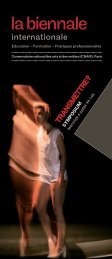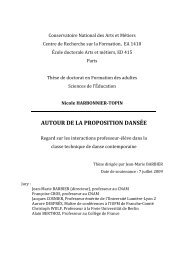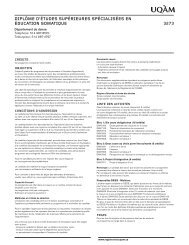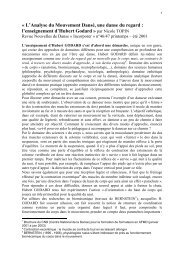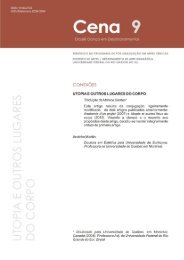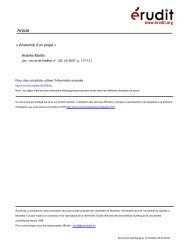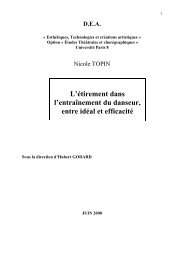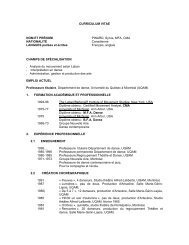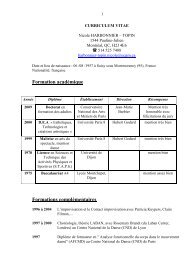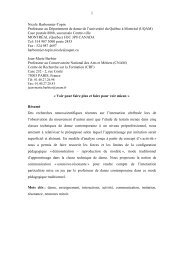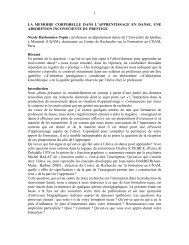Day 2 - Département de danse - UQAM
Day 2 - Département de danse - UQAM
Day 2 - Département de danse - UQAM
You also want an ePaper? Increase the reach of your titles
YUMPU automatically turns print PDFs into web optimized ePapers that Google loves.
In this paper I engage with theories drawn from feminist geographies, recent media and travelogues of Arctic explorers to<br />
examine the extent to which orientalising agendas are at play in the reification of the Inuit and their endangered way of life as<br />
performed in Chouinard’s Les trous du ciel. As part of my “Choreographing the North” project this research asks what it means<br />
to i<strong>de</strong>ntify with “northern” themes; how “northernness” relates to i<strong>de</strong>ntity and the performance of place; and whether<br />
connections exist between physical and metaphysical colonization at the northern-most edge of the world.<br />
“Mounds, Earthworks, Si<strong>de</strong> Show Freaks, and Circus Injuns.” Ric Knowles (University of<br />
Guleph)<br />
I am involved as dramaturge and scholar in a major research/creation project, “Indignous Knowledge, Contemporary<br />
Performance”—fun<strong>de</strong>d in part by the Social Sciences and Humanities Research Council of Canada (SSRHC)—which involves<br />
the <strong>de</strong>velopment of new Indigenous performances based on traditional Indigenous cultural texts. As part this project, Monique<br />
Mojica (Kuna and Rappahannock) and LeAnne Howe (Choctaw) are creating a new work, Si<strong>de</strong> Show Freaks and Circus<br />
Injuns, which employs the <strong>de</strong>ep structure of earthworks, funeral, and effigy mounds of the Indigenous peoples of eastern<br />
Turtle Island. These mounds that with varying <strong>de</strong>grees of <strong>de</strong>nsity, visibility or invisibility, and having suffered varying <strong>de</strong>grees<br />
of <strong>de</strong>secration or “preservation” since, cluster around the Mississippi River and its tributaries, but range from Louisiana in the<br />
Southern US north into Canada. At their peak, as many as 200,000 mounds dotted eastern Turtle Island between 600 and<br />
1300 CE.<br />
Native American scholar Chadwick Allen has argued that these mounds constitute the expressive “literature” of the<br />
Indigenous peoples who created them. The mounds are characterized by a scientific, geometrical, and astronomical<br />
sophistication that is astonishing, and this sophistication directly linked the ecosphere with the heavens. To construct a<br />
dramaturgy that is groun<strong>de</strong>d in the architecture of these mounds is to reconnect with an Indigenous cosmology that remains<br />
unbroken by colonization and mo<strong>de</strong>ls indigenous ways of knowing and being with and in the world. Si<strong>de</strong> Show Freaks and<br />
Circus Injuns, addressing in its content a history (based on the family backgrounds of Mojica and Howe) of the exploitation and<br />
display of Indigenous peoples, at once invisible and hyper visible, is employing the environmental and astronomical optics of<br />
these architectures to construct a new Indigenous dramaturgy that reassesses the people’s relationship to the universe.<br />
“(Re)presentations of Colonial Violence in Monique Mojica’s Birdwoman and the Suffragettes<br />
and Princess Pocahontas and the Blue Spots.” Sarah MacKenzie (University of Ottawa)<br />
Colonial cultural production has too often portrayed Indigenous women as hyper-sexual, irresponsible and impulsive. The<br />
propagation of these images reinforces discourses that inferiorize Indigenous cultures generally, and Indigenous women<br />
particularly, obscuring colonial injustices and diminishing the potential for syncretic postcolonial harmonization. Despite<br />
colonial efforts to silence the voices of Indigenous women, today we are telling their own stories through literature and drama,<br />
reimagining and (re)presenting histories of colonization and, in doing so, subverting the representational and, laterally,<br />
manifest violence to which we have been subject in both historic and contemporary times.<br />
Closely analyzing Kuna/Rappahannock actor and dramatist Monique Mojica’s Birdwoman and the Suffragettes (1991) and<br />
Princess Pocahontas and the Blue Spots (1991), this paper assesses the extent to which Mojica’s works present gen<strong>de</strong>red,<br />
racialized violence as a technology of colonization, which works, together with misrepresentations of Indigenous women, and<br />
with the erasure of cultural memory, as a mechanism of cultural genoci<strong>de</strong>. Ultimately, I contend that, through a resistant<br />
process of reverse interpellation, Mojica reconfigures colonial legacies of violence, particularly sexual violence, by presenting<br />
revisionist histories and subversive self-representations that oppose <strong>de</strong>nigrating colonial <strong>de</strong>pictions. Birdwoman and the<br />
Suffragettes reconfigures the colonialist story of Sacajawea, the Lemhi Shoshone gui<strong>de</strong> and translator to the American Lewis<br />
and Clarke expedition, while Princess Pocahontas encourages Indigenous women to become “word warriors” and “fashion<br />
[their] own gods out of [their] entrails” (168).<br />
Though the postcolonial climate of contemporary North America creates a fraught representational context for Indigenous<br />
dramatic production, Mojica’s works <strong>de</strong>monstrate that Indigenous women playwrights can re-appropriate stereotypes and<br />
disparaging literary tropes and reimagine histories of violence, ren<strong>de</strong>ring apparent the colonial assumptions un<strong>de</strong>rlying these<br />
<strong>de</strong>pictions. In an instrumental resistance of misrepresentations, Indigenous women dramatists <strong>de</strong>stabilize the representations<br />
accor<strong>de</strong>d authenticity by the colonizing power and thereby reconfigure historic power relations.<br />
c) Where Art Meets Science: Theatre Devising at the Edge McIntyre<br />
Praxis Workshop Organizer: Nelson Gray (University of Victoria)<br />
For several centuries, a bifurcation of art and science has left artists and scientists working in isolation from one another. Yet<br />
<strong>de</strong>spite their different methodologies, artists and scientists often share similar concerns and are motivated by common<br />
purposes. This is particularly so in the present era, when human-induced ecological change has wiped out countless species<br />
and brought us to the edge of the planet’s capacity to sustain our own. This 90-minute workshop is <strong>de</strong>signed to reveal and<br />
explore the creative and community-building impact of arts/science collaborations in performance.<br />
30



